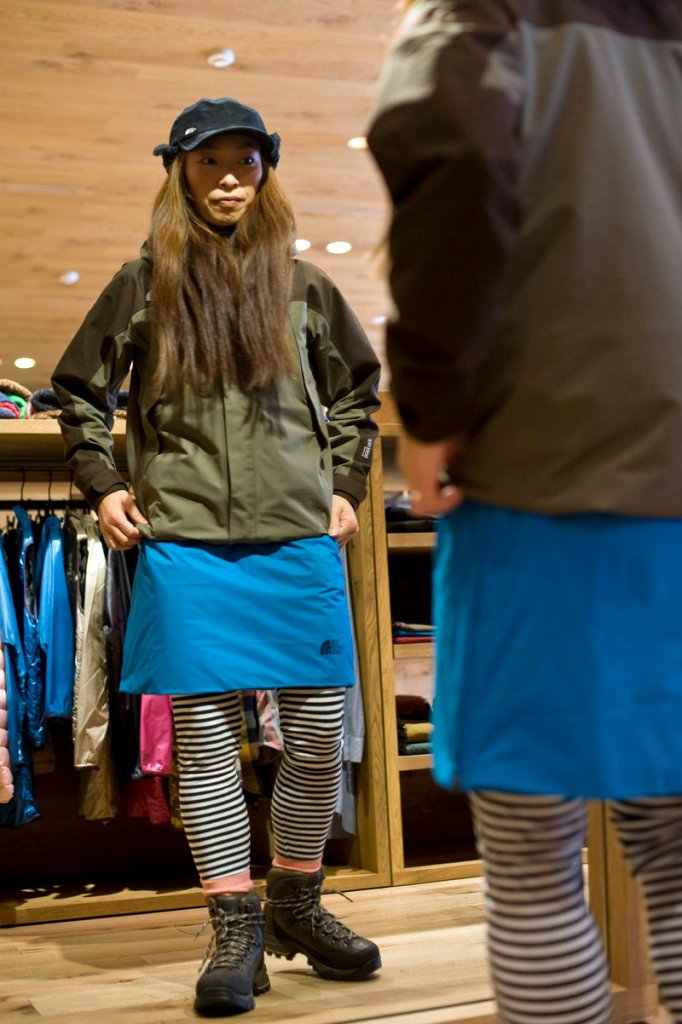TOKYO – Forget the ice ax and $500 climbing boots. The mode du jour for today’s female mountain hikers in Japan is a miniskirt and leggings.
The North Face, a maker of Gore-Tex waterproof jackets, and Alpine Tour Service Co. are targeting “yama girls,” or mountain girls, the nickname for the growing number of women who are taking to the hills of Japan wearing short pants or fleece skirts with leggings and designer trekking boots.
“I want to wear something cute like a skirt,” said Machiko Miyauchi, 25, who made her first ascent of Mount Fuji, Japan’s highest peak, earlier this year after buying new equipment and shoes. “Climbing is healing. You can breathe fresh, clean air.”
Visitors to Mount Fuji in the two months that ended Aug. 31, the busiest climbing season, were the most since the government began tracking traffic using infrared sensors in 2005. The number of women applying for Alpine’s treks jumped sixfold from last year, prompting the Tokyo-based company to increase women-only tours to 13 this year from six in 2009, spokesman Yasushi Kodama said.
Clothing companies have hired mountain fashion pioneers such as Yuri Yosumi to promote new women’s lines for mountaineers. Yosumi’s “Love Trek” website includes red minidresses and pink bush hats from Paris-based Aigle.
Berghaus Ltd., a British outdoor wear maker, introduced skirts jointly developed with Yosumi in 2009, while Jarden Corp.’s Marmot Mountain, a U.S. outdoor clothing company, followed this year, according to Yosumi’s husband, Daisuke.
“We’re giving an option to the market where only pants were available before,” Daisuke Yosumi said.
Japan’s fashion scene has a record of establishing cult trends that sweep the industry, typically for a few years, such as the “ganguro” look that mixed deep fake tans with white lipstick, bright clothes and orange-to-blond hair. Tokyo ranked 14th this year in Global Language Monitor’s annual list of world fashion capitals.
The nation’s top climbing spot is the 12,388-foot Mount Fuji, within sight of Tokyo, where the number of trekkers rose 9.9 percent to 320,975 in July and August, according to a report by the Environment Ministry. About 12.3 million people hiked Japan’s mountains last year, compared with 590,000 in 2008, according to a 2010 Japan Productivity Center White Paper on Leisure, published in July.
“Mount Fuji seems to be a catalyst for many people,” said Machiko Ito, who plans trekking tours at Yama-kei Publishers Co. “It’s like going to Tokyo Disneyland — people get this feeling that everyone else is going, so they will, too.”
Alpine Tour and Yama-kei offered a women-only tour to Fuji for $347 in July, and plan two more all-female tours to other locations in December.
“Single women are spending their spare time on something fashionable and good for their health, as they can’t do it once they get married,” said Toshihiro Nagahama, chief economist at Dai-Ichi Life Research Institute in Tokyo.
With more women remaining in the work force, the trend may continue. The average age for Japanese women to get married for the first time rose to 28.6 last year from 26.3 in 1995, while the birth rate dropped to 1.37 from 1.42 in the same period, according to Japan’s health ministry.
“Mountaineering is a real trend now, tapping into a flow from yoga and running, and this is only happening in Japan,” said Hikari Mori, general manager for the brand at Goldwin. “We want to make outdoor activities a lifetime sport, not just a one-time boom.”
Send questions/comments to the editors.



Success. Please wait for the page to reload. If the page does not reload within 5 seconds, please refresh the page.
Enter your email and password to access comments.
Hi, to comment on stories you must . This profile is in addition to your subscription and website login.
Already have a commenting profile? .
Invalid username/password.
Please check your email to confirm and complete your registration.
Only subscribers are eligible to post comments. Please subscribe or login first for digital access. Here’s why.
Use the form below to reset your password. When you've submitted your account email, we will send an email with a reset code.